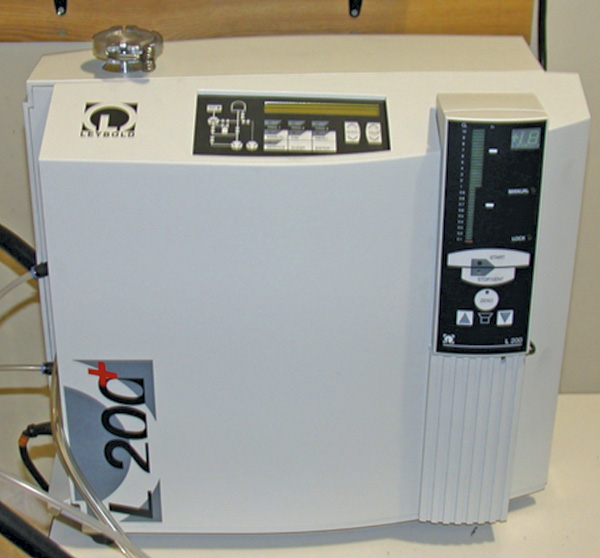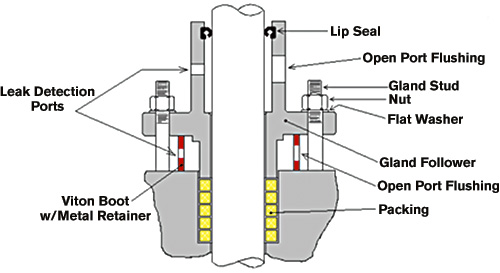Standards groups in the U.S. and abroad have been actively advocating for compression packing used in valve stem sealing. Some of the more relevant provisions and changes are outlined in this article.
The working group (WG 10) for International Organization for Standardization's (ISO) ISO/TC 153/SC 1, which covers industrial valves—including design, materials, manufacturing, testing and inspection—has been working on the second edition of ISO 15848-1 (Industrial valves — Measurement, test and qualification procedures for fugitive emissions — Part 1: Classification system and qualification procedures for type testing of valves). The second edition has reportedly been approved and is expected to be released in the first quarter of 2015.
 Image 1. Helium mass spectrometer (Images and graphics courtesy of FSA)
Image 1. Helium mass spectrometer (Images and graphics courtesy of FSA)Industrial Valve Standard
The standard has undergone notable changes and updates, including:
- The flushing method has been removed from the standard and replaced with two new methods for use with helium test gas.
- Accumulation (based on EN13185) is a bagging method with two specific times at which measurements are taken, and the bag has a defined/confirmed volume.
- The "suck-through" method essentially bags the valve with a vent of a prescribed length to allow outside air into the bag to prevent collapse. Flow rates of the probe are known, and the external air helium levels can be determined prior to the test.
- Units for leakage rates at the packing defined in Table 1 of the standard have been revised to include a mass flow or volumetric flow per millimeter of stem diameter, making it more convenient to match the typical units displayed by the helium mass spectrometers used for this test.
- Class AH (A for the highest sealing level and H for helium testing gas) leakage has been revised to be 1 x 10-5 rather than 1 x 10-6 (using the informational rate of milligrams per second per meter of stem perimeter). At least one test laboratory has indicated that the 1 x 10-6 leakage class has never been achieved with compression packing in rising stem valves, though some could meet the new revised Class A criteria. Class AH is typically achieved with bellows seals or equivalent stem packing sealing systems for quarter-turn valves.
- Methane is now included as a test gas, and the leakage limits are specified in parts per million (ppm): Class AM ≤ 50 ppm, Class BM ≤ 100 ppm and Class CM ≤ 500 ppm (A, B and C are for the sealing level, and M is for methane test gas).
- It was clearly noted that no correlation exists between ppm/methane leakage classes and mass leak rates of helium leakage classes. For this reason, a packing meeting class BH is not necessarily the same as a packing meeting class BM. The requestor specifies using this test method prior to the test.
- In the on-off valve test, the CO1 cycles have been reduced from 500 stem cycles and three thermal cycles to 205 stem cycles and two thermal cycles.
The two new methods give test facilities and end users other options to better suit their needs. These methods also may be easier to set up and run with different valve types. With the addition of methane and sniffing detection methods, some end users will likely consider the ISO standard as an acceptable test method per the Environmental Protection Agency's definition of "good engineering practice" for fugitive emissions testing of valves. This is particularly the case with control valves for which there is no current American Petroleum Institute (API) test method.
Updates to Other Standards
In the U.S., API standards committees are actively working on standards (new or existing) related to fugitive emissions in valves.
API 622
API 622, Type Testing Of Process Valve Packing For Fugitive Emissions, Second Edition, expires in October 2016, but the working group has convened to get a head start on this revision. First, the addition of a test fixture for 1/8 inch cross section packing to simulate packing sizes typical for forged valves is under review. The current edition of the standard defines a test fixture for 1/4 inch packing, which is typical of cast valves. This change would ensure that functionality of the packing being tested extends to multiple valve and packing sizes. Also, the corrosion test portion of the standard is being reviewed for potential changes that would make the test fixture less complicated and reduce the cycle time. Currently, the test can take six to eight weeks.
 Figure 1. API 622 Emission capturing set-up
Figure 1. API 622 Emission capturing set-upAPI 641
API 641, Type Testing of Quarter-turn Valves for Fugitive Emissions, is a new standard currently in development. This standard will define a valve type test similar to API 624, Type Testing of Rising Stem Valves Equipped with Graphite Packing for Fugitive Emissions, First Edition. The 641 standard will likely include both polytetrafluoroethylene and graphite-based packing materials. Exact details of the test conditions are still being developed.
API RP-621
API RP-621- Reconditioning of Metallic Gate, Globe and Check Valves, Third Edition, is actively being revised. This standard defines guidelines for the reconditioning of valve types that are being serviced for continued use in an end user's facility. The new revision will have a complete addendum that defines the requirements for low emissions service, noting that valves in these services are more difficult to seal and, therefore, have more stringent requirements than those for other services (i.e. steam).
In addition to these updates, API 589 Fire Test for Evaluation of Valve Stem Packing, Second Edition was last updated on July 1, 1998. The standard is no longer active in API, so no active committee regularly reviews it. Though the standard can still be found for sale online, it is considered withdrawn.


